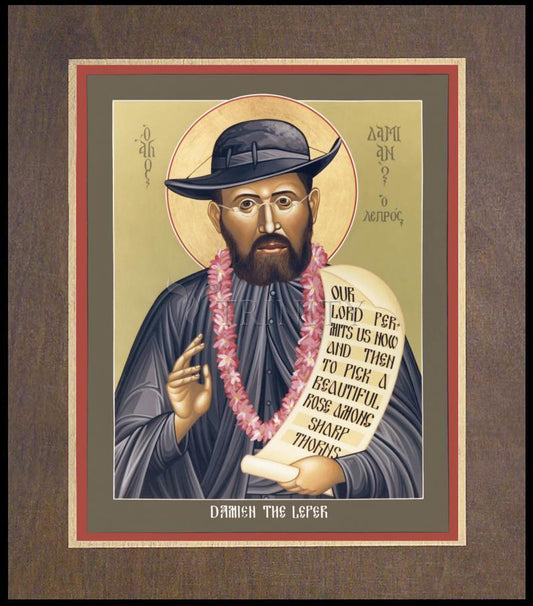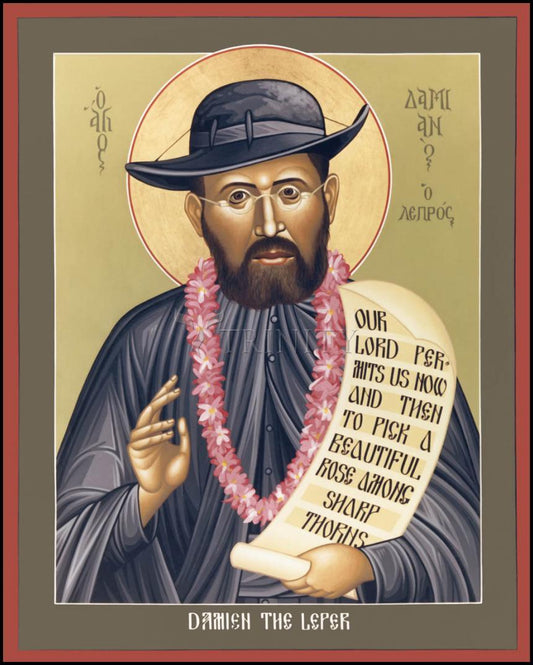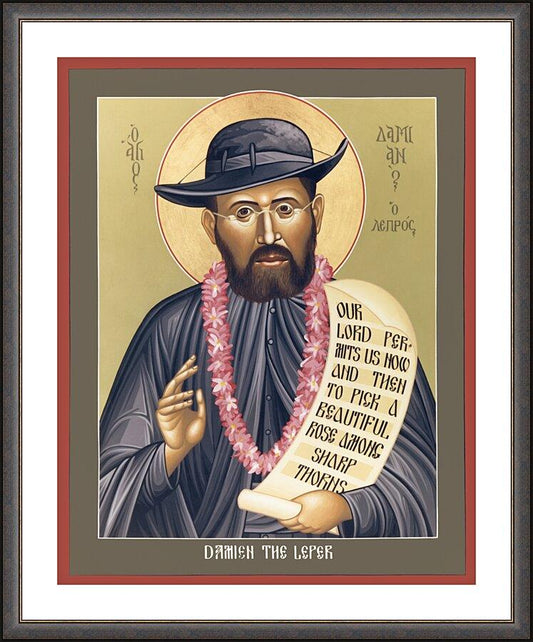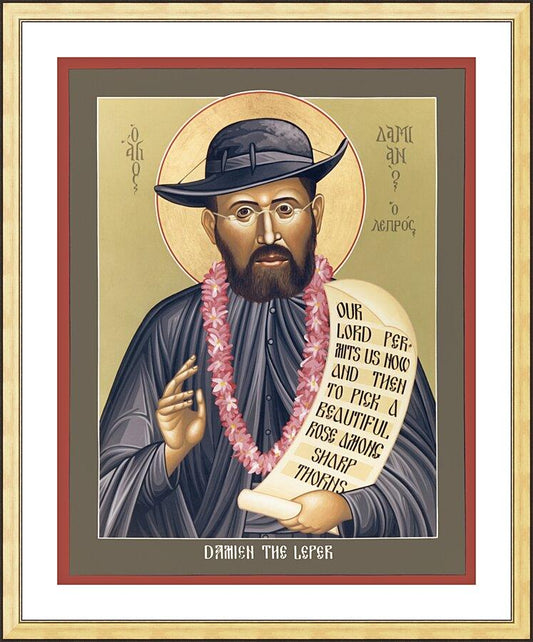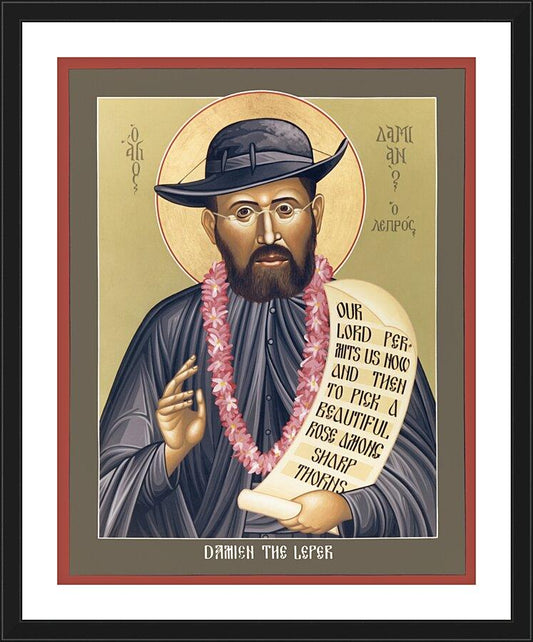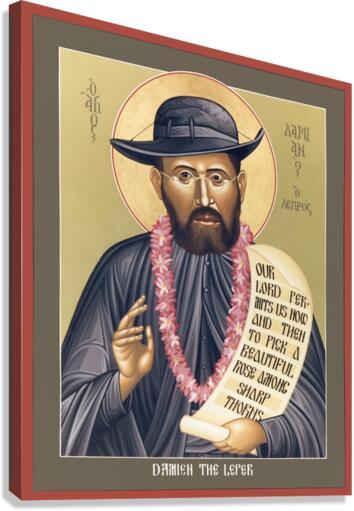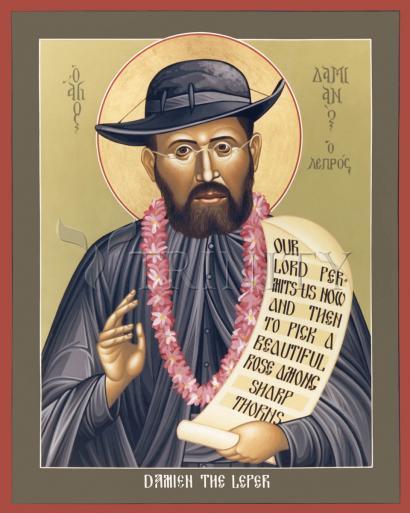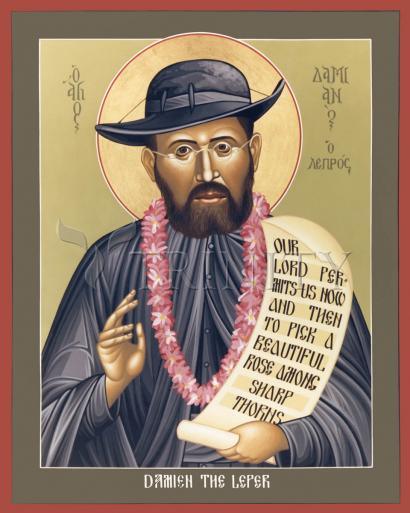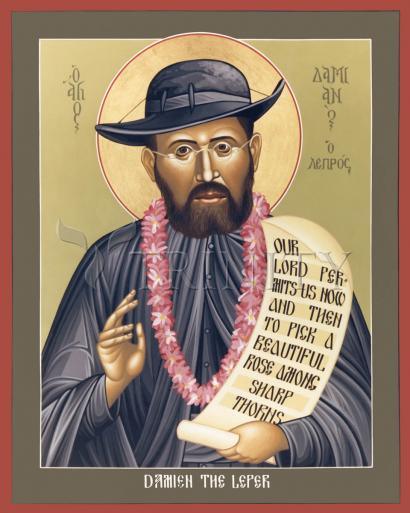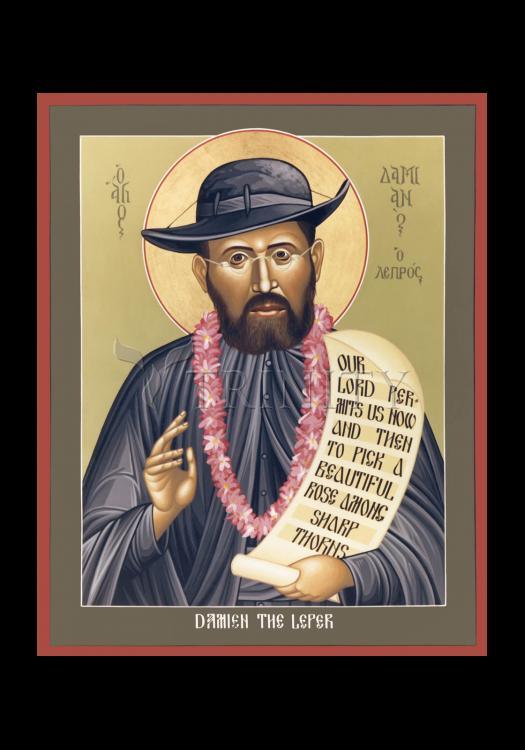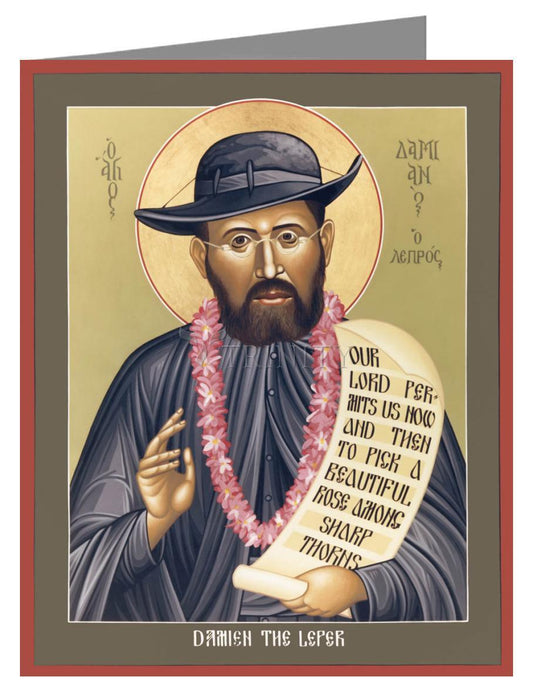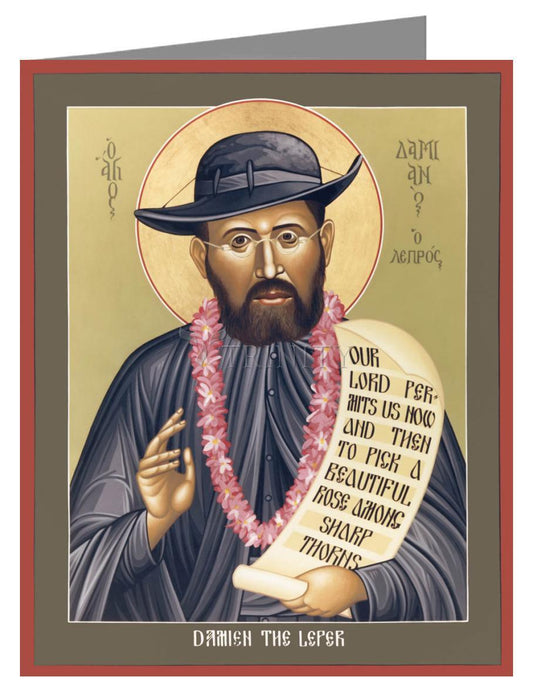Every age has its stories of heroic men and women whose faith challenges them to reach out in heroic love and service to alleviate the sufferings of their brothers and sisters.
This is the story of one such hero. He was born Joseph De Veuster, a Belgian farm boy. He is known now to all the world as Damien the Leper. His bronze figure graces the statuary hall in Washington, D.C.
Damien's compassion for the lepers led him to spend sixteen years in the "living graveyard that was Molokai," where he died at the age of forty-nine in service to people suffering from the terrible disease of leprosy.
Damien never lost sight of his life's purpose, despite the many difficulties and sufferings he bore. It was only his faith that enabled him to endure the trials that his life's work caused him.
We hope that you enjoy this story and find it a source of strength and encouragement.
The Fateful Words:
He read the letter, over and over. "You may stay as long as your devotion dictates...." The words exploded against his mind and shook his heart. Again, and once again, he read them. They were the most welcome words he had ever received.
He stood and listened to the sounds about him. Soft, cool breezes gently swept across his island. The palm trees along the shore bowed before the refreshing winds and clapped their great fronds in joy. Bright morning sunlight played over the trees, turning the leaves, now silver, blue. The Pacific waves rolled tranquilly against the rocky shores. The green and white waters rose and fell; the ocean's motion never stopped, day or night. The restless power locked in the Pacific's waves mirrored the surging energies locked within his own heart.
He was a priest -- a simple man. His parents were Belgian farmers. Nature had prepared his square, sturdy, and well-developed body to till the soil. God had summoned him to labor in a different field -- to cultivate a more violent harvest. The words he now read hammered home this summons.
The letter, from his superiors, gave the priest, Father Damien De Veuster, permission to stay where he was and where he, in the springtime of 1873, longed with all his heart to be. On Molokai, one of the Hawaiian Islands. Father De Veuster, thirty-three, had already served nine years in the Hawaiian missions. He was a member of the Fathers of the Sacred Hearts, who had pioneered Catholicism in the islands. These religious had faced and overcome enormous problems since their arrival in 1827. Now they faced a new and frightful challenge, a leprosy epidemic. To halt the spread of the dread disease, the Hawaiian government had isolated several hundred lepers at Kalawao, on the island of Molokai. Catholic lepers there begged for a priest.
Many missioners, despite danger of contagion, had offered to go. The Bishop, Louis Maigret, and Father Modeste, the religious superior of the Sacred Hearts Fathers, had selected Damien to begin the mission. Both were reluctant to put such a crushing burden permanently on this young priest's square and sturdy shoulders. The Bishop and Father Modeste knew the bitter work that had to be done; they hesitated to demand that this one man do so much of it.
Thirteen years before, while a student for the priesthood in France, Damien had symbolically faced and accepted death. At the public profession of his final vows, as was the religious custom of the times, his superiors covered him with a funeral pall. He had truly believed then that only by accepting death would he discover life. Now, thirteen years later, he was putting his dedication to the test. He sought to serve the most pitiful of all men, the lepers of Molokai. By so doing, in the words of Robert Louis Stevenson, "he shut to, with his own hands, the doors of his own sepulchre."
Men Discover Hawaii:
The Hawaiian Islands, one of the most beautiful places in all of God's creation, were one of the last places on earth that men discovered. God was saving, it seems, his choicest gift for the last. Polynesian explorers, the first men to find the islands, settled there about eight centuries after Christ's birth. A thousand years later, during the American Revolution, British sailors, under Captain Cook, were the first Europeans to reach this paradise.
Europeans found about three hundred thousand people on the islands. The natives, cheerful, unspoiled, easy-going unless provoked, were generous, delighted in sports and athletic contests. A highly organized native religion dominated every aspect of Hawaiian life.
Living was easy in the islands. The people readily obtained fish, fruit, vegetables, and meat. Hawaiians lived in little homes constructed of palm branches. Daily life was pleasant, cheerful, uncomplicated.
As contact with the outside world increased, the Hawaiians, with no immunity to European and Asiatic diseases, suffered immensely. Smallpox, influenza, cholera, tuberculosis, venereal disease, struck savagely and pitilessly. Within a hundred years of the white man's arrival, the native population dropped from three hundred thousand to fifty thousand people. In the long litany of ills decimating the Hawaiian people, none was more vicious than leprosy. This hideous disease cut an evil swath through the defenseless natives of our planet's Last Eden.
Leprosy:
One of man's oldest curses, leprosy for centuries defied cure or remedy. To prevent its spread, Moses had separated and isolated Jews afflicted by it from the community. Roman legions and, later, Crusaders brought the disease to Europe. Authorities, having no better remedy than Moses, ordered lepers segregated from the cities and towns. Lepers were ordered to wear bells around their necks to warn people of their approach. By the year 1000, monks had constructed more than two thousand leper hospitals in Europe. They were called Lazar houses after the Gospel's poor leper, Lazarus. Friars often lived in hidden leper settlements, serving the outcasts' physical and spiritual needs. Although the disease ran its course through western Europe, by the turn of the nineteenth century the memory of it remained sunk in the white man's brain like the terror of a nightmare. Even today the word "leprosy" evokes in the minds and hearts of people who have never seen a leper, the strangest sensations of fear and repulsion.
The first authenticated case of leprosy appeared in Hawaii in 1840. Within thirty years the disease reached epidemic proportions among the defenseless Hawaiians. Authorities, helpless and ill-equipped, adopted the only policy they knew, the policy of segregation. In 1868, the Hawaiian government established a leper settlement on the island of Molokai, and officials were dispatched to round up the lepers. Ideally equipped by nature for its grim purposes, Molokai became an island of sorrow in the wild beauty of the Hawaiian chain. Its very name struck terror in the Hawaiian heart.
Hawaiians gave little thought to tomorrow; and had no worries about robbers, since village families held all things in common. They ate, slept and worked on the family straw mat.
The Outside World:
Between 1866 and 1873, seven hundred and ninety-seven lepers arrived at Molokai. Almost half died. Public indignation mounted. The Board of Health, which natives wryly dubbed the "Board of Death," sought to improve conditions. The government granted an increase in leper food and clothing rations, and appointed a superintendent to restore law and order to the colony. The press kept up a drum-fire of complaints about the ill-treatment and disorder of Molokai. In April, 1873, Walter Gibson, a colorful and clever politician, wrote in Nuhou, a Hawaiian newspaper; "If a noble Christian priest, preacher or Sister should be inspired to go and sacrifice a life to console these poor wretches, that would be a royal soul to shine forever on a throne reared by human love."
Despite the fulsome prose, Gibson was trumpeting a call, a challenge. There were indeed several men in the islands, only too willing to respond. They were good shepherds, searching for a flock for which they could lay down their lives. They were priests and Brothers of the Sacred Hearts. One of them was Father Damien De Veuster. Call it presentiment, prophecy, or anything you wish, but Damien had known for some time that he would eventually go to Molokai. In April, 1873, he wrote his Father General in Europe about his mission in Kohala, Hawaii, where he was stationed. "Many of our Christians here at Kohala also had to go to Molokai. I can only attribute to God an undeniable feeling that soon I shall join them.... Eight years of service among Christians you love and love you have tied us by powerful bonds." And join them he did. In early May, 1873, Father Damien's superiors approved his request to serve at the leper settlement.
The New Pastor:
Bishop Maigret accompanied Damien to Molokai. The Bishop proudly presented the new pastor to the Catholic lepers. The joy of their welcome and Damien's excitement upon finally arriving at Molokai, dimmed the fact that he carried with him little more than his Breviary. Sacred Hearts religious previously had built a tiny chapel on Molokai, and had dedicated it to St. Philomena. For his first rectory, Damien used the shelter of a pandanus tree, beside the little church. The pandanus offered hospitality to all passing creatures, centipedes, scorpions, ants, roaches and, finally, fleas. Cats, dogs and sheep found shelter under the tree's kind branches. Damien settled in comfortably. A large rock on the side of the tree served as his dinner table. During these first weeks the new missionary took normal precautions to avoid contagion.
With the lepers' help, Damien added the rear wing to Molokai's chapel. He also built the rectory . The priest was a skillful carpenter. No construction project daunted him.
But if Damien protected his body, there was nothing he could do to protect his eyes or ears or sense of smell from the shock of contact with the leper. Here at Kalawao, the priest had opened a door to hell. Victims of the disease were all about him, their bodies in ruins, their faces ravaged and smashed by the voracious bacillus of leprosy. The constant coughing of the sick was the colony's most familiar sound. Gathering up his enormous resources of courage, Damien began to approach the lepers one by one. Their breath was fetid; their bodies, already in a state of corruption, exuded a most foul odor. One of his first visits was to a young girl. He had found that worms had eaten her whole side.
"Many a time," he wrote as he recalled these first days, "in fulfilling my priestly duties at the lepers' homes, I have been obliged, not only to close my nostrils, but to remain outside to breathe fresh air. To counteract the bad smell, I got myself accustomed to the use of tobacco. The smell of the pipe preserved me somewhat from carrying in my clothes the obnoxious odor of our lepers."
Molokai was a colony of shame, peopled by lost souls and smashed bodies. Medical care was minimal. Even if decent care were provided, Hawaiians distrusted the white man's medicine, preferring their own witch doctors, or kahuna. White doctors sporadically appeared at government expense. These physicians lived in terror of contagion. One doctor examined lepers' wounds by lifting their bandages with his cane. Another left medicine on a table where lepers could collect it without touching him.
Life was grotesque on Molokai. Ambrose Hutchinson, a veteran of half a century in the colony, describes an incident in the settlement's early days. "A man, his face partly covered below the eyes, with a white rag or handkerchief tied behind his head, came out from the house that stood near the road. He was pushing a wheelbarrow loaded with a bundle, which, at first, I mistook for soiled rags. He wheeled it across the yard to a small windowless shack.... The man then half turned over the wheelbarrow and shook it. The bundle (instead of rags it was a human being) rolled out on the floor with an agonizing groan. The fellow turned the wheelbarrow around and wheeled it away, leaving the sick man lying there helpless. After a while the dying man raised and pushed himself in the doorway; with his body and his legs stretched out, he lay there face down."
Molokai was a chamber of horrors. But the Hawaiian government (which at this time was independent of the United States and headed by native royalty) had not planned it that way.
Plans Gone Awry:
The Board of Health had put much thought into the leper settlement's establishment. It chose Molokai because its geography was ideal for enforcing the isolation and segregation policy. Like other Hawaiian islands, Molokai was formed by a volcanic eruption from the ocean floor. As the fires under the crust of the earth exploded upward, Molokai rose out of the sea, a spectacular palisade reaching three to four thousand feet above the ocean. A later eruption within the high island poured hot lava into the sea. The volcanic flow piled up until it formed a shelf at the base of Molokai's high cliffs. This peninsula sticks out into the ocean like a dirty brown furrowed tongue. There is no way to leave the peninsula except to plunge into the ocean or to climb up the huge vertical precipice surrounding the peninsula on three sides. The Board of Health knew that the peninsula was a natural prison, for no one suffering the ravages of leprosy could possibly scale the cliffs surrounding the colony. Most of Molokai's non-leper population lived on the high plateau which embraces more than ninety percent of the island's land area. The leper colony was established at Kalawao on a part of the peninsula described above.
Molokai's first lepers lived on, died on, and were buried in their mats. Authorities expected these poor people, weakened and crippled by their disease, to till the rich soil, raise cattle, and feed themselves. At first the government provided a few miserable grass huts for shelter. Abandoned lepers perished from hunger and cold.
Molokai's palisades are covered with heavy green vegetation. Great cataracts of water from the frequent rainstorms that lash Molokai, plunge down her cliffsides. At certain seasons of the year, winds carrying chill and dampness, cascade down from the mountains onto the leper colony. Huddled in their flimsy huts, the lepers suffer grievously from the cold. "A heavy windstorm," Damien reported after arrival, "blew down most of the rotten abodes, and many a weakened leper lay in the wind and rain with his blanket and wet clothing."
Father Damien was deeply moved by leper children. He struggled to preserve them from the physical and moral corruption of Molokai.
Damien's Colony Of Death:
At the outset of his mission Damien aimed to restore in each leper a sense of personal worth and dignity. To show his poor battered flock the value of their lives, he had to demonstrate to them the value of their deaths. And so he turned his attention first to the cemetery area beside his little chapel. He fenced it around to protect the graves from the pigs, dogs, and other scavengers. He constructed coffins and dug graves. He organized the lepers into the Christian Burial Association to provide decent burial for each deceased. The organization arranged for the requiem Mass, the proper funeral ceremonies, and sponsored a musical group that played during the funeral procession.
Damien continued to minister to the sick, bringing the Sacraments of confession and Holy Communion and annointing bedridden lepers. He washed their bodies, bandaged their wounds and tidied their rooms and beds. He did all he could to make them as comfortable as possible.
He encouraged lepers to help him in all his activities. With their assistance he built everything from coffins to cottages. He constructed the rectory, built a home for the lepers' children. When the colony expanded along the peninsula to Kalaupapa, he hustled the lepers into construction of a good road between Kalawao and Kalaupapa. Under his direction, lepers blasted rocks at the Kalaupapa shoreline and opened a decent docking facility. Damien taught his people to farm, to raise animals, to play musical instruments, to sing. He watched with pride as the leper bands he organized marched up and down playing the music Hawaiians love so well. No self-pity in this colony. Damien's cheerful disposition and desire to serve touched the lepers' hearts without patronizing or bullying them. Little by little their accomplishments restored the sense of dignity their illness threatened to destroy.
Under Damien's vigorous lead, a sense of dignity and joy -- and order replaced Molokai's despair and lawlessness. Neat, painted cottages, many of which the priest himself constructed, replaced the colony's miserable shacks.
He harried the government authorities. In their eyes he was "obstinate, headstrong, brusk and officious." Joseph Dutton later on speaks of him as "vehement and excitable in regard to matters that did not seem to him right, and he sometimes said and did things that he afterwards regretted..., but he had a true desire to do right, to bring about what he thought was best. No doubt he erred sometimes in judgement.... In certain periods he got along smoothly with everyone, and at times he was urgent for improvements. In some cases he made for confusion, as various government authorities would not agree with him."
In all things his lepers came first. It would be a mistake, however, to think of Damien as a single-minded fanatic. He was a human being who was quick to smile, of pleasant disposition, of open and frank countenance.
No one could deny that he was a headstrong person. But no one who knew him could deny that he was a man of warm and tender heart. He quickly forgave injuries and never bore a grudge.
Charles Warren Stoddard, an American writer, first visited Molokai in 1868, five years before Damien's arrival. He returned in 1884. In place of the miserable huts of the colony's beginning, Stoddard now found two villages of white houses, surrounded by flower gardens and cultivated fields. Molokai boasted a decent hospital, a graveyard, and two orphanages filled with children. But what delighted Stoddard most of all was that the men and women, instead of rotting in the slime, awaiting death, were out horseback-riding.
In 1888, the Englishman Edward Clifford visited Damien. "I had gone to Molokai expecting to find it scarcely less dreadful than hell itself," Clifford wrote, "and the cheerful people, the lovely landscapes, and comparatively painless life were all surprises. These poor people seemed singularly happy."
Clifford asked lepers if they missed not being back home. They replied, "Oh, no! We're well off here. The government watches over us, the superintendent is good, and we like our pastor. He builds our houses himself, he gives us tea, biscuits, sugar and clothes. He takes good care of us and doesn't let us want for anything."
The Knight Commander:
The Hawaiian government decorated Father Damien with the Cross of the Royal Order of Kalakaua. The priest accepted the award but rarely wore the medal. In later stages of his own illness, Damien remarked, "The Lord decorated me with his own particular cross -- leprosy."
If some white missionaries scorned Father Damien, most Hawaiians loved him. In September 1881, Hawaiian Princess Liliuokalani visited Molokai. The Princess, moved deeply by the lepers' suffering, was unable to give the speech she had prepared. Leaving Molokai with a broken heart, she returned to Honolulu and requested Father Damien to accept the Hawaiian Order of Knight Commander of the Royal Order of Kalakaua in recognition of his "efforts in alleviating the distress and mitigating the sorrows of the unfortunate." With pleasure, Damien accepted the award. He felt it would bring attention to his lepers. There were many Americans, too, both in Hawaii and on the mainland, who recognized the work that Damien was doing and who sent, with characteristic American generosity, funds and other forms of help to him. In Honolulu, American Protestants were among his most generous benefactors. Opening their hearts and their purses to Damien, they sent him food, medicines, clothing, and all sorts of help for his mission.
Damien The Leper:
One day in December, 1884, while soaking his feet in extremely hot water, Father De Veuster experienced no sensation of heat or pain. The evil disease he had battled for so long now claimed him. In his last years he engaged in a flurry of activity. He hastened to complete his many building projects, enlarge his orphanages, organize his work. Help came from four unexpected sources. A priest, a soldier, a male nurse, and a nun. The soldier, Joseph Dutton, was the most unusual man. He had survived Civil War combat, a broken marriage, several years of hard drinking, to show up on Molokai's shores in July, 1886. He stayed forty-five years without ever leaving the colony. He served the lepers of the Baldwin Home for Boys. Joseph was never seriously ill until just before his death in 1931. He was just short of eighty-eight. Another layman, James Sinnett, a man who had a colorful and checkered career, during which he gained some experience in nursing in Mercy Hospital, Chicago, came to Molokai eight months before Father Damien died. The leper priest called him "Brother James." He nursed Father Damien during the final phase of his illness, and closed his eyes in death. During the last days of Damien's life, Sinnett served as his secretary. He was faithful to the very end, and when Damien died, Sinnett left the colony. Nothing was heard from him thereafter.
Father Louis-Lambert Conrardy, a fellow Belgian, joined Father Damien May 17, 1888. Archbishop William Gross of Oregon generously permitted Father Conrardy to leave his own priest-poor area to labor in Molokai. Archbishop Gross wrote of Conrardy: "I have trampled all over Oregon with Father Conrardy and he is a noble, heroic man.... Though he knows and realizes perfectly that he might succumb to the disease, his voluntary going is real heroism." Conrardy and Damien joined in their unreserved dedication to the lepers. Along with this, Conrardy provided the spiritual and social companionship that Damien so desperately craved.
The Sister who now offered at this critical junction support for Damien and his work, was Mother Marianne Kopp, Superior of the Franciscan Sisters of Syracuse, New York, who served the Honolulu leper hospital. Damien requested Mother Marianne to send Sisters to care for the girls' orphanage at Molokai. Damien promised her that not one of her Sisters would ever be afflicted with leprosy. The Franciscan Sisters of Syracuse are still at Molokai. To this day, not one of them has ever contracted leprosy.
Damien's Last Days:
In October, 1885, Damien wrote his superior, Father Leonor Fouesnel, in the Hawaiian Islands: "I am a leper. Blessed be the good God. I only ask one favor of you. Send someone to this tomb to be my confessor." (This was three years before Conrardy's arrival.) He wrote his General in Rome, "I have been decorated by the royal Cross of Kalakaua and now the heavier and less honorable cross of leprosy. Our Lord has willed that I be stigmatized with it.... I am still up and taking care of myself a little. I will keep on working...."
The announcement that Damien had leprosy hit his own religious superiors, Father Fouesnel and his bishop, Hermann Koeckemann, like a thunderbolt. Damien was the third Sacred Hearts missionary stricken with leprosy. To prevent further infection, Father Fouesnel forbade Damien to visit the mission headquarters of the Sacred Hearts Fathers in Honolulu. "If you come," Father Superior advised Damien, "you will be relegated to a room which you are not to leave until your departure." Father Fouesnel suggested that if Damien insisted on coming to Honolulu, he stay at the Franciscan Sisters' leper hospital. "But if you go there," the superior counseled, "please do not say Mass. For neither Father Clement nor I will consent to celebrate Mass with the same chalice and the same vestments you have used. The Sisters will refuse to receive Holy Communion from your hands." One can understand the superior's concern. But Damien was being forced, nevertheless, to consume the bitter wine of loneliness to its dregs. He now knew not only the physical sufferings of Christ but the harrowing loneliness and abandonment of his Savior. Damien did go to Honolulu and remained at the leprosarium from July 10 to 16. It was during the time that he arranged with Mother Marianne to come to Molokai. He spoke of his rejection by his own as "the greatest suffering he had ever endured in his life."
The Sorrowful Mother:
Catherine De Veuster, Damien's mother, had lived all these years on the occasional letters he wrote to her from Molokai. He had tried to keep her from the news of his leprosy. But inevitably she found out. Someone advised her that the newspapers said, "the flesh of the leper priest of Molokai was falling off in hunks." It was too much for Catherine. Now eighty-three years of age, a widow for thirteen years, the shock of the sufferings of her son broke her old heart. On April 5, 1886, about four in the afternoon, turning her eyes for the last time toward the image of the Blessed Mother and the picture of her son, she bowed her head in that direction and died calmly and peacefully.
Doctor Mouritz, medical attendant at Molokai, charted the progress of the physical dissolution of Damien's body. He writes: "The skin of the abdomen, chest, the back, are beginning to show tubercles, masses of infiltration.... The membranes of the nose, roof of the mouth, pharynx, and larynx are involved; the skin of his cheeks, nose, lips, forehead, and chin are excessively swollen.... His body is becoming emaciated."
An ever-deepening mental distress accompanied Damien's physical dissolution. A severe depression, as well as religious scruples, now plagued the leper priest. Damien felt he was unworthy of heaven. The rejection by his religious superiors left him in near disarray. Once he claimed: "From the rest of the world I received gold and frankincense, but from my own superiors myrrh" (a bitter herb). His superiors complained about Father Conrardy's presence on Molokai. Conrardy was not a religious of the Sacred Hearts, and they felt that Damien had encouraged his presence there as a reproach to their ineffectual efforts to provide him with a companion. Soon after Damien's death, the Sacred Hearts superiors maneuvered Father Conrardy out of the colony.
As death approached, Father Damien engaged in a flurry of activity. He worked as much as his wounded and broken body would permit him. He wrote his bishop, entreating not to be dispensed from the obligation of the Breviary, which he continued to recite as best he could as his eyes failed. The disease invading his windpipe progressed to such an extent that it kept him from sleeping more than an hour or two at night. His voice was reduced to a raucous whisper. Leprosy was in his throat, his lungs, his stomach, and his intestines. After ravaging his body outwardly, it was now destroying him from within.
As the end drew near, there were priests of his own Congregation to hear his confession. They had come with the Franciscan Sisters. On March 30, one of them, a Father Moellers, heard Damien's last confession. The leper priest had requested a funeral pall, which the Sisters made for him and delivered from Honolulu. It arrived the same day. Two more weeks of suffering, and on April 15, 1889, Damien died. It was Holy Week. Some weeks before, Damien had said that the Lord wanted him to spend Easter in heaven.
Once he had written, "The cemetery, the church and rectory form one enclosure; thus at nighttime I am still keeper of this garden of the dead, where my spiritual children lie at rest. My greatest pleasure is to go there to say my beads and meditate on that unending happiness which so many of them are enjoying." And now it was his turn to occupy a little plot of ground in "his garden of the dead."
He no longer meditated on that unending happiness, but now most surely possessed it. Long ago he had selected the precise spot for his grave amid the two thousand lepers buried in Molokai cemetery. Coffin bearers laid him to rest under his pandanus tree. It was the same tree that had sheltered him the day he read those fateful words: "You may stay as long as your devotion dictates...."
—Originally published in 1974 by the Franciscans of St. Anthony's Guild, Patterson, New Jersey.



